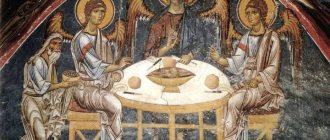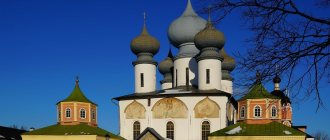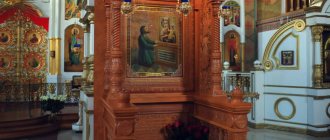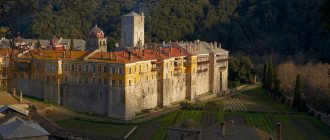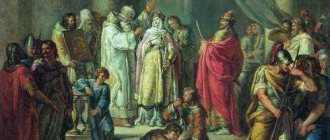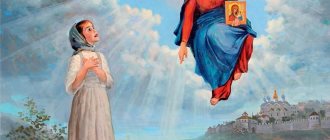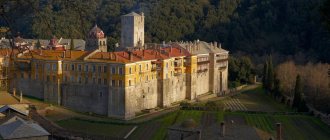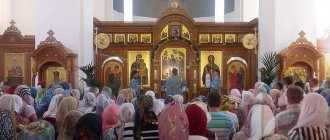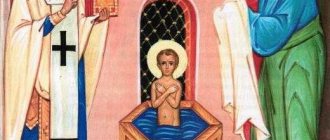There are dozens of options that will capture one significant event with paints on boards - the meeting of three wanderers. The history of the shrine is described in chapter 18 of the Book of Genesis and transferred to icons with symbolic meaning, either depicting scenes with Abraham and his wife, wanderers, or depicting the plot of the appearance of three angels before Abraham.
However, the most famous among all the icons is the icon of the Holy Trinity, representing the Trinity of God, painted by Andrei Rublev.
A little theology: who is depicted in the icon
Before us is an image of the Holy Trinity, as a rule, thoroughly symbolic. Each icon painter conveyed to the viewer his vision of the visualized dogma of Christianity. If in some images it is often clear to the viewer who is which of the divine characters, then in others the differences between them are erased.
Not in every image of the Trinity do we see the personification of all three hypostases of God. Often, instead of human figures, icons depict flames or a dove, symbolizing the Holy Spirit. Invariably, only Jesus Christ is depicted in human form on most icons.
The Holy Trinity. Greece. End of the 12th century
Theologians are still debating whether this or that image corresponds to church canons. The most global subject of discussion is the image of God the Father. Unlike Jesus Christ, no one has seen God the Father, so how can his appearance be conveyed? - say some theologians. Others object to them, quoting the words of the Savior: “He who has seen me has seen my Father.”
From a human point of view, God the Father must a priori be older than his own son. But in 1667, the Moscow Council forbade depicting the Father in the image of an old man. However, icons with the Elder Father still exist.
Therefore, the oldest images of the Trinity that have come down to us (and these are frescoes of the 2nd century AD) belong to the type of Old Testament icons, that is, they depict three men. A little later, the Divine Trinity began to be displayed in the form of three angels, and after the 16th century its image became more symbolic and plotless.
New Testament icons include more or less narrative iconographic types, for example, “Co-throne” and “Fatherland”. They contain images of the Father and the Son (by the way, the Father usually appears in the form of an old man), but the Holy Spirit is depicted in the form of a dove.
On the left is the “Co-throne”, on the right is the “Fatherland”.
The thoroughly allegorical “All-Seeing Eye”, “Eternal Light”, “Sex Day” and others like them are also considered New Testament. Many theologians believe that these images cannot be classified as icons at all, but this does not prevent ordinary people from worshiping various types of visualized images of the Trinity.
History of writing the icon
The most famous icon of the Trinity was painted by the icon painter Andrei Rublev, famous for centuries. Despite the fact that many centuries have passed since the creation of the masterpiece, its authorship is practically beyond doubt. Sometimes alternative hypotheses are put forward, but no serious confirmation is found.
According to one hypothesis, the creator of the icon was an unknown Italian icon painter. This is proven by the analysis of the icon, in which the influence of the Italian school of painting is clearly noticeable. Allegedly, Ivan the Terrible himself brought this image to the Lavra. However, according to the official version, thanks to the monarch, the icon only received a luxurious robe.
In general, the creation of the Trinity icon by Andrei Rublev is considered a generally accepted fact. According to the official version, the icon painter created it at the behest of Abbot Nikon, in praise of Nikon’s legendary predecessor, Sergius of Radonezh.
It was in a monastery that later became known as the Trinity-Sergius Lavra. And the image was intended for the new Trinity Church, erected to replace the burnt wooden church of the same name.
Scientists have different opinions about the year the icon was created - either 1411 or 1425-1427. One thing is clear: the “Trinity” immediately took pride of place on the right side of the altar and began to serve as an object of worship. But the main shrine of the temple at all times was considered the relics of St. Sergius of Radonezh.
Andrey Rublev. "Trinity".
"Trinity" has been updated several times. In fact, on top of Rublev’s images, icon painters painted new ones that corresponded to modern trends, even if they repeated the original plot. As a result, Rublev’s “Trinity” disappeared under numerous layers of paint.
And only at the beginning of the last century, after removing the chasuble and several openings (freeing from later layers of paint), Andrei Rublev’s masterpiece appeared before admiring spectators as the genius intended it.
The icon has suffered greatly from time to time: it is painted on a wooden board, and this is not a very durable base. However, the bright festive colors, lovingly painted by Rublev’s brush, still delight the eye of a true connoisseur of art.
Where is the original icon located?
After the revolution, the icon was nationalized and removed from the closed Trinity-Sergius Lavra. It went first to the museum, organized in one of the buildings of the former monastery, and then to the Tretyakov Gallery fund. The Rublev Trinity resides there permanently, with the exception of its forced evacuation during the Great Patriotic War.
And in the Sergius Lavra there is now a list of the “Trinity”, written by Nikolai Baranov in the last century.
The original icon is placed in a special icon case and stored in special conditions: an optimal temperature and humidity regime has been created for it. And only once a year, on Trinity Sunday, it is taken with unimaginable care to the temple-museum at the Tretyakov Gallery.
Representatives of the Russian Orthodox Church have repeatedly raised the issue of returning the Trinity to the Lavra. However, art historians have proven that transportation can cause irreparable damage to a masterpiece of Orthodox icon painting, let alone storage under normal conditions. “Trinity” was left in the Tretyakov Gallery.
Icon "Trinity" in the hall of the Tretyakov Gallery
Sacred texts
The initial prayer to the Most Holy Trinity is the first phrase of one of the 3 initial prayers of all liturgical sequences of Orthodox Christians. The short sacred text contains the following words:
The translation of the prayer “Holy Trinity, have mercy on us” in Russian is:
The full version of the prayer to the Holy Trinity contains the following words:
In the prayer text, the word “Trinity” is used in the ancient vocative case “Trinity”. There are also other Orthodox prayers to the Most Holy Trinity in different rites.
People turn to the Holy Trinity with various petitions. For example, when a person faces an unfair accusation, it is worth reading the following prayer:
If a believer is in danger, one must turn to higher powers with the following words:
Troparion for the Feast of the Holy Trinity, tone 1:
Kontakion of the Feast of the Holy Trinity, tone 2:
Iconography
Let us give a brief description of the Trinity in the form in which Andrei Rublev showed it to us. The plot of the icon speaks of the Old Testament history, which laid the foundation for one of the main dogmas of Orthodoxy.
According to a text from the Old Testament, Abraham was once visited by three mysterious travelers. He sat them down at the table and treated them to various dishes, for which he was awarded the revelation of the birth of Isaac. Two travelers soon left (according to legend, to punish the city of sinners Sodom), and one remained to talk with the future founder of the Jewish people.
The most ancient versions of the icon depict male travelers in a realistic form. The images contain the figures of Abraham and his wife Sarah, and the surroundings of the action are documented.
Rublev's icon looks a little different. The artist depicted the Trinity in the form of angels similar in appearance, but there are no images of Abraham and his wife Sarah in the composition.
Angels sit at a table on which stands a bowl with the head of a sacrificial animal - a reference to Christ's sacrifice for humanity. The angels are exactly the same, which hints at the trinity, but behind each one there is a personal background.
Behind the back of the central angel is written a tree (Tree of Life, an allegorical image of paradise lost). Usually this image is identified with God the Father. Behind the back of the angel sitting on the left is a temple (symbol of the Holy Spirit), sitting on the right is a mountain (symbol of Golgotha and the feat of Jesus Christ). Nevertheless, there are other interpretations of the deepest symbolism of the image.
The images seem to be united in an invisible circle. And at the table there is a free place where the person looking at the icon mentally sits. This is a symbol of the invitation addressed to each of us: there is a place for everyone at the table next to God.
Thus, it turns out that not the personified Father, Son and Holy Spirit are depicted at the table, but the angels symbolizing them. The artist gives visual clues, but the viewer is asked to figure out for himself which of these angels is which.
Appearance of the Trinity
Believers celebrate another important holiday - Epiphany. It is also associated with the appearance of the Trinity. According to legend, John the Baptist in the Jordan River baptized everyone who decided to connect their lives with God and came to repent. Among those wishing to be baptized was Jesus himself, because he considered it his duty to be baptized. When Christ was in the river, and John was performing a sacred action, a miracle happened - the Holy Trinity appeared. It was the Lord's voice from heaven, the Savior himself and the Holy Spirit, descending in the form of a dove to a pond.
Another significant event for the Orthodox world was the appearance of the Holy Trinity to Abraham. Although the man had no children, the Lord promised that his descendants would have a great future. Abraham was already old when he and his wife stopped in the oak groves of Mamre. One day three travelers came to their tent. One of them said that the wife of the righteous man would give birth to a son next year. And so it happened. The Church says that in the prophet Abraham recognized the Lord himself, and the three travelers together are the Holy Trinity.
The meaning of the Holy Trinity icon
This image means, first of all, the visualization of the idea of the trinity of God. The Life-Giving Trinity is something united and whole, which is one of the basic dogmas of Christianity.
As mentioned above, there are many images of this type, from realistic to completely symbolic. Many of them are not recognized as canonical and, from the point of view of the official church, are simply paintings on religious themes. But what can we say, even if Rublev’s “Trinity” still causes a lot of theological controversy!
Nevertheless, the main meaning of the icon, no matter what means it is conveyed, remains unchanged: the trinity of God. And among the many additional meanings, one more can be identified, important for every believer: the road to the Kingdom of Heaven is open for each of us.
Where can you venerate the shrine?
The image, painted by Andrei Rublev, was created in the 15th century. This icon has not only ecclesiastical, but also artistic value. Thanks to her, the image was not destroyed during the reign of the atheistic Soviet regime. After restoration, the shrine was placed in the Tretyakov Gallery. Here she remains to this day.
Fortunately, in 1997, a bright tradition was born: on Pentecost, the image is taken to the Church of St. Nicholas in Tolmachi.
Two copies of the image created by Rublev are kept in the Holy Trinity Sergius Lavra (Sergiev Posad). Both copies are placed on the iconostasis of the Trinity Cathedral.
In addition, the list of the image is also located in the Danilov Monastery (Moscow).
The list we have given is far from complete. In total, more than one and a half thousand churches were built in Russia, consecrated in honor of the Holy Trinity. It is logical that in every such parish there is an icon of the Life-Giving Trinity. In addition, such images are often placed in other churches consecrated in honor of saints or the Virgin Mary. Therefore, most likely, such a shrine is also present in the temple nearest to you.
You can also, of course, pray in front of this shrine at home. Before ordering this image for your iconostasis, make sure that the image is canonic and whether it has been consecrated. Unfortunately, sometimes non-canonical images are found on sale in church shops. Therefore, be careful!
How does the image help believers?
This image is not as popular among believers as icons of the Savior, the Mother of God and even especially revered saints (for example, St. Nicholas). Nevertheless, the image of the “Trinity” is in many churches and houses of believers, and Trinity churches were built in almost all major cities Russia.
Sincere prayer to the icon helps:
- improve health, get rid of diseases and addictions;
- get a hint in a difficult life situation;
- strengthen in faith and take the path of piety;
- comfort after a difficult loss;
- to receive the fulfillment of your most cherished desire (of course, if it is not directed towards evil).
The most powerful prayers are for those who have strong faith. Before asking something from the Life-Giving Trinity, it is advisable to fast, confess and take communion - in a word, to purify yourself as much as possible before the face of the Lord.
Silver pendant "Holy Trinity"
The most significant miracle in the history of the icon is considered to be its assistance to Ivan the Terrible during the capture of Kazan. Before sending troops to the heart of the Khanate, Ivan Vasilyevich ordered a prayer service to be held in the Trinity-Sergius Lavra. And after the fall of the considered inaccessible stronghold, the monarch prayed to the icon in person for a long time, praising the Trinity. It was then that the image received its first precious robe.
A miracle created in this way
The miraculous face has long been famous for its properties, which are confirmed by many stories, one of which is associated with the name of the well-known Russian Tsar Ivan the Terrible:
Before setting off on a military campaign against the kingdom of Kazan, Ivan the Terrible went to the divine shrine in the Trinity-Sergius Lavra. From the chronicles found, it is known that the king cried out very fervently and for a long time in a prayer service before the Holy Face, asking for protection and blessing for the capture of Kazan.
As a result, the enemy was truly defeated, and having returned in triumph back to Rus', John again visited the Lavra, where he spent more than one hour in tears and prayers, expressing his gratitude to the Lord God.
Icon day celebration
Unfortunately, the Trinity icon never received its own holiday. Most likely, this is due to the ambiguous attitude of the Orthodox clergy towards this graphic representation of the Divine Trinity.
However, there is a major church holiday - Trinity Day, which is celebrated on the fiftieth day after Easter (hence the alternative name - Pentecost).
It is believed that on this day the truth about the trinity of God was revealed to humanity. True, it is associated not with the Old Testament, but with the Gospel event. On this day the descent of the Holy Spirit on the apostles took place.
In accordance with the Old Testament and the Pentateuch, on this day the prophet Moses received the Tablets on Mount Sinai. They contained the Ten Commandments of God, by which a God-obedient Jew (and later a Christian) must live.
History of the divine shrine
The miraculous image has a plot based on the story from the Book of Genesis, where in chapter 18, the meeting of three wanderers was depicted, personifying the trinity of the Lord with Abraham. The composition of the image itself was initially based on some scenes given in the book of Genesis, i.e. wanderers, Abraham and his wife and various scenes of existence. And therefore the shrine received the second name “Hospitality of Abraham.”
After some time, events from real life in the image began to acquire a completely new meaning - symbolic, while the angels (wanderers) began to be revered as a symbol of the Trinity of the Lord, and their appearance before Abraham was called the appearance of the Holy Trinity.
This was the beginning for the formation of several main variations in the writing of the shrine: on one of them, all three angels are drawn equal to each other, and on the other, the central angel is highlighted with a large halo or with the help of the sign of the Lord.
The best article for you, go to: Icon “Sovereign” Mother of God, what helps and meaning
Other famous icons of the Holy Trinity
Rublev’s masterpiece is the most famous, but far from the only one of the ancient icons of the Holy Trinity. This image was painted many times before and after it, and Rublev’s icon received numerous copies, sometimes far from the prototype.
For example, the so-called Zyryan icon, painted back in the 14th century, supposedly by the enlightener Stefan of Perm, is known. The genius managed to convey the basic idea of the trinity of God in the most accessible form for the dark pagans, who were the Zyryans (Komi-Permyaks) at that time. The plot of the icon is quite classic (as in the image of Rublev), and the image is supplemented with a quotation from the Old Testament, translated into the Zyryan language.
The image of the Trinity of Theophan the Greek dates back to approximately the same period, although this is not an icon, but a fresco in the Church of the Transfiguration in Novgorod. In this work, there is a clear primacy of one of the angels (most likely symbolizing God the Father), and there is an image of Sarah. Obviously there was Abraham, but his image collapsed along with the plaster.
Theophanes the Greek. Fresco "Trinity".
The icon of Simon Ushakov was painted much later, already in the 17th century. It actually duplicates the plot of Rublev’s creation, but with some adjustments that bring it closer to secular painting. The mountain no longer symbolizes Golgotha or Mount Sinai (depending on the interpretation), God's temple has been turned into something antique, and the head of the sacrificial calf in the bowl has been replaced by a luxurious table setting.
Trinity Old Testament
Christian art faced a difficult task - to convey the Revelation of the Trinity visually. The visual symbolism of the early era offered an option that became entrenched in iconography. In the Roman catacombs of the 4th century. on Via Latina there is a fresco where three strangers appear to Abraham. It is based on the biblical story about the meeting of the forefather Abraham and three men near the oak grove of Mamvre (Gen. 18: 1-16). As is known, this episode was interpreted by theologians of the early Church in different ways. Some saw in him the appearance of God in Three Persons, others - the appearance of God accompanied by two angels.
Hospitality of Abraham. Mosaic of the presbytery of the Church of San Vitale. Ravenna. 546-547
In the naos mosaic [7] c. Santa Maria Maggiore (Rome, 5th century) the subjects “The Appearance of Three Strangers to Abraham” and “The Hospitality of Abraham,” where he treats the guests sitting at the table, are combined in one composition. Abraham offers the calf, Sarah prepares the bread. On the left is Abraham's house and a small tree. In the mosaic of the presbytery [8] c. San Vitale in Ravenna (546-547) the composition “The Hospitality of Abraham” includes a scene of the sacrifice of Isaac. The theme of sacrifice (Eucharistic) is heard here twice. On the left, a servant hands the three strangers a prepared calf on a platter; on the right, Abraham raises a sword over his son. A lamb is already standing nearby, and God (the blessing hand from heaven) stops Abraham. Behind Isaac there is a mountain depicted - a mountain in the land of Moriah (Gen. 22: 1-19). In the center, three guests are sitting at a table under a tall, spreading oak tree; Sarah is standing in the doorway of the house on the left. Already in these early monuments an iconographic scheme was outlined, which “is of a completely theologically meaningful nature” [9].
In subsequent centuries, the composition “The Hospitality of Abraham” will appear in many versions, but most often, in addition to the three strangers sitting at the table, it includes the figures of the forefathers Abraham and Sarah, sometimes their servant, slaying the calf and preparing the meal. Abraham's house, a tree (the oak of Mamre) and hills are often depicted.
The prepared throne (Etimasiah). Mosaic of the Church of the Assumption in Nicaea. End of the 7th century
During iconoclasm, anthropomorphic images of the Holy Trinity were replaced by symbolic ones. One of the most famous, even from the pre-iconoclastic period, is a mosaic from the end of the 7th century. “The prepared throne” (Greek Έτοιμασία - “readiness”) from the Church of the Assumption in Nicaea, which, unfortunately, was preserved only in photographs of the late 19th century by the Russian Archaeological Institute in Constantinople. The Throne here means the Kingdom of God the Father. The book on the Throne is a symbol of the Logos, the Second Person of the Holy Trinity, and the dove that descends on it is a symbol of the Holy Spirit [10].
In the post-iconoclastic era, the "Hospitality of Abraham" iconography once again proliferates in Byzantine art. At this time, various compositional schemes are developed. Forefathers Abraham and Sarah can be located in the foreground, to the right or left of the Angels, between them. Sometimes they look out from the windows of the chambers or are not depicted at all (fresco in the Church of St. George. Djurdjevi Stupovi Monastery near Stari Ras. Serbia, 12th century). In monumental painting, two independent compositions are often dedicated to the subject of the Trinity: “The Appearance of Three Angels to Abraham” and “The Hospitality of Abraham.” As a rule, in the painting of the temple they follow each other (frescoes of the Cathedral of St. Sophia in Kiev, 11th century; Church of St. Sophia in Ohrid, Macedonia, 11th century; mosaics of the Cathedral of Monreale in Palermo, Sicily, 12th century, etc. .).
The dwelling of Abraham, the Oak of Mamre, the hills, and especially the servant slaying the calf are not always depicted. A common feature is the selection of a cup at the table (Throne) with a prepared (sacrificed) calf. Isocephaly, a frontal composition with an equal-sized image of Angels, characteristic of early monuments, gives way to a triangular scheme in the Komninian and Paleologian periods. According to I. Yazykova, “at an early stage, it was important to affirm the unity of the hypostases in the Holy Trinity; at a later time, the hierarchical idea was emphasized” [11].
Meeting of Abraham and three angels. Hospitality of Abraham. Mosaic of the Monreale Cathedral. Palermo, Italy. XII century
The iconography of “Abrahamic hospitality”, or the “Trinity of the Old Testament”, came to Rus' in the 11th century. The fresco in the Cathedral of St. Sophia of Kyiv dates back to this time. The image on the southern and western gates of the Cathedral of the Nativity of the Virgin Mary in Suzdal dates back to the 13th century, and the famous fresco of Theophanes the Greek in the Novgorod Church of the Transfiguration on Ilyin Street dates back to 1378. Icons from the 14th and early 15th centuries are known. (four-part Novgorod icon of the 14th century; the so-called “Zyryan Trinity” from Vologda, late 14th century; Pskov icon with an isokephal composition of the late 14th - early 15th centuries)
How to pray to the image correctly, where to place the icon in the house
According to Orthodox traditions, icons should be hung on the eastern side of the home, but if there is not enough space there, you can place the home altar on any other wall. It is better if there are no household appliances, worldly books and paintings nearby.
In the home iconostasis, the “Trinity” is usually placed above the central image of the Savior. If you wish, you can purchase an icon for your car or personal use. Or you can buy a bracelet or pendant with the image of the Life-Giving One.
Texts of prayers
There are many canonical prayers to the Holy Trinity, both asking and thanking. It is not necessary to learn them by heart (although it is advisable); you can carefully and respectfully read the text from a sheet or brochure.
Of course, God also hears sincere prayers uttered in his own words, but it is better not to replace them, but to supplement them with canonical texts.
Prayer of thanksgiving and majesty for the holiday of Trinity
In the name of the Father God, the Son and the Holy Spirit, we pray for forgiveness and mercy on this bright and festive day. Three times our only heavenly Father, we offer words of joy on this holiday, we are in Your house and bow to the images in the hope of instruction and deliverance from illnesses and sins that burden our souls. We proclaim the true faith and convey from mouth to mouth words of gratitude for our lives in Thy goodness and mercy. We pray for everyone living on earth, living under Your gaze. Bless, Lord, a righteous life in mercy and goodness. Grant us, God, to live it in reverence for You and in raising children according to Your indisputable and only righteous covenants. Amen.
Prayer for health and healing
O most merciful God, Father, Son and Holy Soul, worshiped and glorified in the indivisible Trinity, look kindly upon Thy servant (name), who is sickly possessed; forgive him all his sins; give him healing from his illness; restore his health and bodily strength; Give him a long and prosperous life, Your peaceful and exemplary blessings, so that together with us he brings grateful prayers to You, the All-Bountiful God and my Creator. Most Holy Theotokos, through Your omnipotent intercession, help me to beg Your Son, my God, for the healing of God’s servant (name). All saints and angels of the Lord, pray to God for His sick servant (name). Amen.
Prayer for fulfillment of desires
To the Most Holy Trinity, the Consubstantial Power, all the good Wines that we will reward You for everything that You have rewarded us sinners and unworthy before, before you came into the world, for everything that You have rewarded us every day, and that You have prepared for all of us in the world to come ! It is fitting, then, for so much good deeds and generosity, to thank Thee not just in words, but more than in deeds, for keeping and fulfilling Thy commandments: but we, being aware of our passions and evil customs, have cast ourselves into countless sins and iniquities from our youth. For this reason, as unclean and defiled, do not just appear before Your Trisholy face without coldness, but below Your Most Holy Name, speak to us, even if You Yourself had deigned, for our joy, to proclaim that the pure and righteous are loving, and sinners who repent are merciful and kindly accept. Look down, O Divine Trinity, from the height of Your Holy Glory upon us, many sinners, and accept our good will, instead of good deeds; and give us the spirit of true repentance, so that, having hated every sin, in purity and truth, we may live until the end of our days, doing Your most holy will and glorifying Your sweetest and most magnificent name with pure thoughts and good deeds. Amen.
It should be remembered that the icon of the Trinity is not a painting or a talisman. This is a sacred relic intended for communication with God. It definitely shouldn’t be hung on the wall just for beauty, and the holy image will show miracles only when the person praying deeply and wholeheartedly believes in God!
16.09.21
Where to hang it correctly in the house
The image of the Holy Trinity is one of the most revered in Christianity. It is believed that its supremacy should be valued above any other icons, visibly defining the power and supremacy of the Lord. Therefore, when placing a home iconostasis, it is recommended to place this canvas in the center of other images. Only one Trinity icon can be used.
Important! In Orthodoxy, you need to perform prayer ascensions facing the east. For this reason, our ancestors always hung all church images on the eastern side of the house. According to the canons of the modern church, such rules do not exist; the main thing is that the iconostasis should be freely accessible for prayer services.
The icon of the Holy Trinity can be hung at the head of the bed. This will serve as additional powerful protection against dark forces and negativity. It is also customary for the Orthodox to place the church canvas near the front door. This prevents negative or witchcraft energy from entering the apartment. There is an opinion that the powerful protection emanating from the icon neutralizes even the most evil guest and all his dark intentions towards his family or hosts disappear in an instant.
Fig 4 The Holy Trinity Icon can be placed anywhere and in any room. It is important that the room itself is spacious, bright and clean. It is necessary to position the iconostasis so that you can always come up and read a prayer with a lit candle.
The icon of the Holy Trinity is placed on a shelf or in a special cabinet. If there are several images, the icon with the Trinity plot is placed above the rest. Experienced parishioners claim that the correct order of arranging icons in the house helps to quickly discover the true path to God and increase one’s spiritual level.
It is not recommended to place the icon close to:
- household appliances, TV;
- next to photographs of deceased relatives;
- paintings, art books, souvenirs;
- idols and icons belonging to another religion.
It is better to place the icon on a special stand or on a table covered with a white tablecloth. If possible, towels embroidered in folk or church style are used for this purpose. The room for storing icons should be light and spacious, so that it is fashionable to quickly concentrate on reading the prayer.
The priests focus the attention of believers on the fact that it is not important where and how the icon of the Holy Trinity will hang in the house. The important thing is how sincerely a person will pray before her and keep all the commandments of God. The main rule here is a reverent attitude towards the place where church shrines are located. It should not look neglected and sloppy. Then any prayer, even read in your own words, will certainly be heard by the Heavenly Patrons.
Where is the Trinity icon located?
As church ministers recommend, this icon must be hung in a certain place in the house, and you can place the shrine alone, or you can place it together with a whole red corner. • In the Christian faith, it is recommended to say a prayer while turning to the east, and based on this, the divine face in the apartment must be hung on the eastern wall. In addition, more space needs to be freed up in front of the icon. All this is explained by the feeling of complete comfort and immersion of the believer while reading a prayer in front of the miraculous icon, so that the person praying does not feel any inconvenience when communicating with the Lord. • It should also be said that there is another place where you can place the shrine; it can be hung above your head by the bed. Thus, the divine face will become a heavenly intercessor for the believer. • But in most Christian homes, the shrine is located on the opposite wall of the entrance to the apartment in order to protect one’s home from various negativity. But the location of the icon in the house is not so important, because how often and how pure the thoughts of the person who turns to the Holy Face plays a big role.
You can not only place it on the wall, but also make a special shelf for the Shrine. When you have a couple of miraculous icons in the red corner of your home, in this case it is advised to place them a little higher than the other images. There is a legend that says that if holy images are placed in the right order, they can open a person’s path to the kindest and happiest future.
Why do they pray?
Confessional prayers are often addressed to the Most Holy Trinity. Before her icon they pray:
- about pardon, salvation, forgiveness and cure for diseases;
- about giving hope;
- about solving various problems.
- about direction on the right path in a difficult life situation;
- about restoring justice and protection from enemies;
- about getting rid of melancholy and sadness.
The prayer text helps in times of temptation and trial. He will take away the depressing experiences. It will help get rid of sin or negativity, but only if the person praying has strong faith. They pray to the Most Holy Trinity for the fulfillment of desires, but it should not concern material wealth. It is worth asking for the fulfillment of spiritual needs. For example, about achieving your goals, about the opportunity to help a loved one, etc.
On the day of Pentecost, as on many other holidays, they pray for the dead so that they find peace in the other world. You can also cry out for other needs, because the Lord is merciful and will help in any situation if the believer’s heart is pure.
There is much evidence that the Holy Trinity helped people overcome various diseases, even in cases where medicine was powerless.
